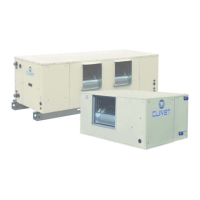M42740M4-02 02/10/08 page 9
WATER CONNECTIONS
GENERAL
Piping must be designed with the least possible number of
bends and head variations. If the pressure chute of the
installation is above the useful prevalence of the pump, the
water delivery capacity is reduced as well as, as a
consequence, the thermal exchange and the yield.
INTERCEPTING VALVES
Install on the input and output of the user parts
(exchangers, coils, humidifiers, etc) So that it will be
possible to carry out all the service operations and possible
substitutions without emptying the installation.
PRESSURE AND TEMPERATURE INDICATOR
Install on the input and output of the user parts
(exchangers, coils, humidifiers, etc) So that it will be
possible to carry out all the service operations.
AUTOMATIC OR MANUAL ESCAPE VALVES
Install the highest points of tubes in a way that the air can
escape form the circuit.
BLEEDING COCK
Install them at the lowest points of the circuit, so as to allow
emptying.
LEAKAGE TESTS
Before performing the insulation of the tubes, carry out a
leakage test.
TUBE INSULATION
All tubes of water must be insulated so that to avoid the
formation of condensation and thermal dispersions along
the tubes themselves. Verify that the insulation is the
vapour coil type. The connections for the air escape and for
the emptying must be out of the insulating thickness to
assure the accessibility.
CONNECTIONS SUPPORTS
The weight of the hydraulic connections must be supported
in the exterior of the unit so as not to stress the connections
of user devices (exchangers, coils, humidifiers, etc ) .
ANTI-VIBRATION DEVICES
In case of units with anti-vibration devices, it is necessary to
assemble elastic joints, even on water connections.
RISK OF FREEZE
If the unit and the relevant water connections are subject to
temperatures near 0°C:
• mix the water of the system with glycol
• protect the tubes with heating cables under the tubes
insulation
• empty the system by verifying that:
o no taps are closed so they can not trap the water,
even after emptying
o there are no low points where the water can
stagnate even after emptying; blow if necessary
INSTALLATION EMPTYING
The refilling of the water present in the installation increase
the oxidation phenomena and lime deposits.
If necessary empty only the interested system section and
anyway empty or refill the installation if necessary .
EXPANSION TANK
The installation must be kept at the right pressure by both
an expansion tank and a combined valve of pressure
reduction and discharge; if the components are present on
the unit, they must be installed on the installation. The
expansion tank must be dimensioned in function of the
water in the installation.
MAX. WORKING PRESSURE = 10 Bar
ARIES EFFECTS AND AIR BUBBLES CAN PRODUCE
THE OVERCOMING AND CAUSE WATER DROPS.
CONDENSATE DISCHARGE CONNECTION
The condensate must be dispersed to avoid damages to persons and
property.
1. Unit discharge fitting : the connection must avoid the transmission of
mechanical stresses and must be performed paying attention to avoid
the damaging of the unit discharge fitting
2. Make a trap that, eliminating the depression caused by the fan, stops
the return of gas from the discharge pipe (see the figure).
3. Connect the condensate discharge to a rainwater drain. Do NOT use
sewerage drains, so as to avoid the return of odours if the water
contained in the trap evaporates.
4. Finally, check that the condensate will drain correctly by pouring water
into the tray stud.
WATER HEATING COIL
OPTIONAL - The position of the connections is shown on
the dimensional drawing of the unit.
The air valve is placed on the top of the coil manifold, it is
used to eliminate possible air bubbles on the circuit.
The discharge valve is placed on the bottom of the
manifold, it is used to empty the coil if it is unused for a
long period.
TO AVOID THE FREEZE FORMING INSIDE THE COIL
1. If the unit or the relevant water connection are
subjects to temperatures next to 0°C see RISK OF
FREEZE in the GENERAL WARNINGS paragraph.
2. The freeze forming is possible also in summer in
abnormal operating conditions (ex. Insufficient air
flow-rate for clogged filters). It is so recommended
to glycolate or empty also in summer

